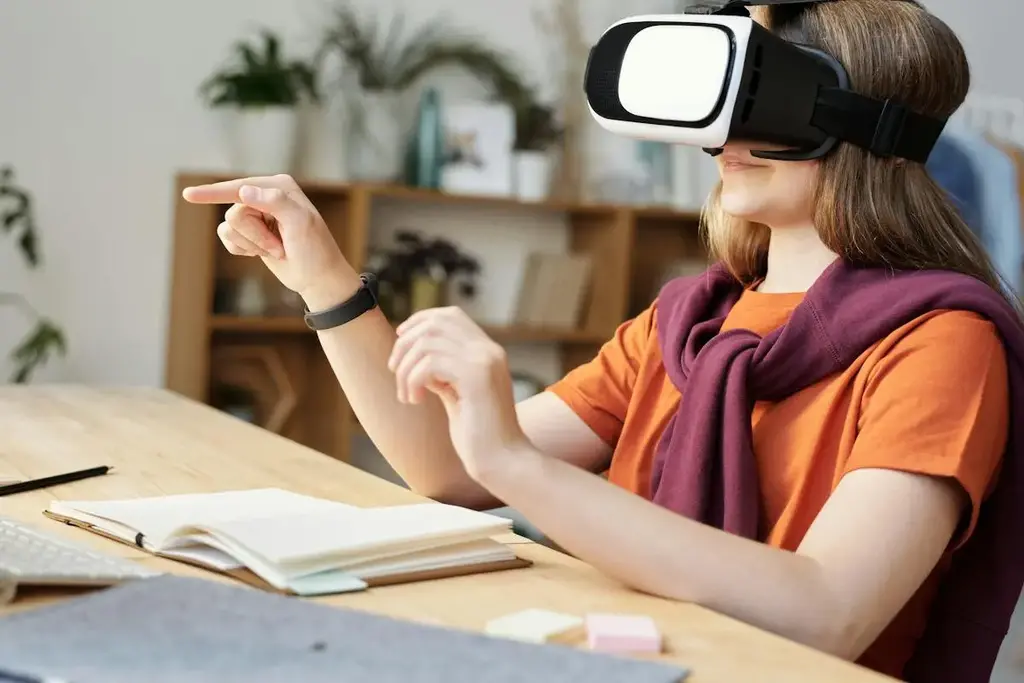Introduction to virtual reality in education
Virtual reality in education has the potential to revolutionize the way students learn. It offers an immersive and interactive experience that can make learning more engaging and memorable. With virtual reality, students can explore complex concepts and visit places they might not otherwise have access to. This technology allows for a more hands-on learning experience, which can help students develop a deeper understanding of the subject matter.

Advantages of implementing VR in the education system
Virtual reality (VR) in education offers several advantages, such as enhancing student engagement and improving knowledge retention. Some key benefits of implementing VR in the education system include:
- Improved Engagement: VR technology allows students to experience immersive and interactive learning environments, which can significantly increase their engagement and interest in the subject matter.
- Enhanced Learning Experience: By providing students with virtual simulations and visualizations, educators can make complex concepts more accessible and understandable, leading to improved knowledge retention and comprehension.
- Real-world Application: VR enables students to explore and interact with realistic scenarios that may not be feasible or safe in real life, allowing them to apply theoretical knowledge to practical situations.
- Personalized Learning: Virtual reality can accommodate individual learning styles and preferences, offering personalized experiences that cater to diverse student needs and abilities.
These advantages demonstrate the potential of virtual reality to transform and enrich the education system.
Use cases of VR in different educational settings
VR is being used in various educational settings to enhance learning experiences. Some use cases include:
- Classroom: VR can take students on virtual field trips to historical sites, museums, and even outer space, providing an immersive learning experience.
- Science Labs: Students can explore complex scientific concepts in a virtual environment, allowing for hands-on experimentation without the physical limitations of a traditional lab.
- Medical Schools: VR simulations enable students to practice surgical procedures and diagnostic techniques in a realistic yet risk-free environment.
- Training Programs: VR is used to train professionals in industries like aviation, engineering, and military, providing realistic scenarios for practice and learning.
Overcoming challenges with VR integration in education
VR integration in education faces several challenges that need to be addressed for successful implementation. These challenges include cost, technical requirements, and accessibility. The initial investment for VR technology can be high, and not all educational institutions have the resources to afford it. Moreover, ensuring that VR systems are compatible with existing technology and accessible to all students can be a hurdle. Therefore, addressing these challenges is crucial for widespread adoption of VR in education.
How VR positively impacts student learning
VR technology has been shown to enhance student engagement and comprehension. According to a study by Stanford University, students who learned through VR had better retention and understanding of complex subjects compared to traditional teaching methods. VR allows students to explore and interact with virtual environments, making learning more interactive and immersive. This helps students retain information better and improves their overall learning experience.
VR technology and its impact on student engagement
Virtual reality (VR) technology has shown promising potential in boosting student engagement. Studies have indicated that the immersive experience provided by VR can enhance students’ focus and involvement in the learning process. VR enables students to interact with virtual environments, which can stimulate their curiosity and make learning more enjoyable. This technology has the capability to transform traditional classroom experiences and create a more interactive and captivating educational environment.
Implementing VR in the classroom – best practices
To effectively implement virtual reality in the classroom, consider the following best practices:
- Start with clear learning objectives: Understand how VR can enhance the learning experience and tie it back to the curriculum.
- Provide adequate training: Ensure that teachers are comfortable with using VR technology and understand how to integrate it into their lesson plans.
- Promote collaboration: Encourage group activities and discussions within the VR environment to enhance interaction and engagement.
- Ensure accessibility for all students: Make sure that VR technology is inclusive and accessible to all students, regardless of their abilities or needs.
- Evaluate and monitor usage: Regularly assess the impact of VR on student learning and make adjustments as necessary.
By incorporating these best practices, educators can maximize the potential of virtual reality in the classroom.
Future trends and developments in VR education
The future of VR in education is looking exciting. Analysts predict that the VR education market will continue to expand, driven by technological advancements and increasing adoption in schools and universities. Some key trends and developments to watch out for in the coming years include:
- Integration of VR into mainstream education curriculum
- Development of more immersive and interactive educational VR content
- Expansion of VR educational applications beyond traditional subjects to include vocational training and specialized skills development
- Collaboration between tech companies, educators, and content developers to create tailored VR learning experiences for different age groups and learning styles
Stay tuned as we explore how VR is revolutionizing the way we learn and engage with educational content.
Evaluating the cost and accessibility of VR in education
Virtual reality (VR) technology comes with various costs and accessibility considerations in the education sector. The initial cost of VR headsets and equipment may pose a significant investment for educational institutions. However, the decreasing costs of VR hardware and the availability of educational content can make VR more accessible for schools. Additionally, the accessibility of VR is influenced by factors like technical support, software development, and the integration of VR into the curriculum. Costs and accessibility are vital aspects to consider when evaluating the potential of VR in education.
Conclusion and potential impact of VR on the future of education
In conclusion, virtual reality (VR) has the potential to revolutionize education by providing immersive and interactive learning experiences. The use of VR in education can lead to increased student engagement, improved comprehension of complex concepts, and the ability to explore and interact with simulated environments. Furthermore, VR has the potential to make education more accessible to students who may not have access to traditional resources. As technology continues to advance, the integration of VR into educational settings could become more widespread, leading to a shift in the way students learn and educators teach.
